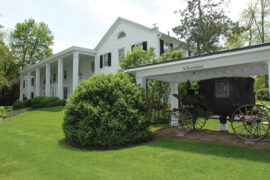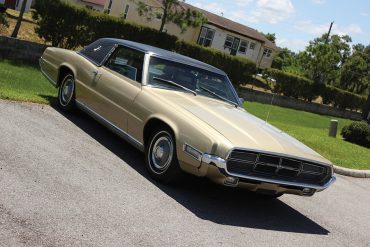No longer a diamond in the rough, golf enthusiast Ed Allen has transformed a run-down public course into a finely polished gem.
By David Walsh
HQ 45 | AUTUMN 2002
When golfers exit Route 152 onto Sugarwood Drive for the short ride to the clubhouse, what they behold now in no way resembles what they gazed upon 22 years ago when Ed Allen started his tenure as the new owner of Sugarwood Golf Club. In layman’s terms, the 18-hole public course has undergone a major transformation.
Those rock hard fairways, scraggly rough, cement-like and severely sloped back-to-front greens – just to name a few of the nightmares – are gone. A watering system, cart paths, clubhouse with improved access and a layout suited for all styles of play – just to name a few of the amenities – have made Sugarwood Golf Club a retreat for golfers of all skill levels.
“My goal was to make this a better place to come,” Allen says. “If I hadn’t, they’d have found other places to go to.”
Allen, 59, started to develop a passion for golf when he was eight and worked as a caddy at the hilly, private 18-hole Spring Valley Country Club in Huntington where he would later work as assistant pro. “I got golf in my blood,” he says. In 1980, Allen left Walden Golf and Tennis Club in Aurora, Ohio to take over for Harold Van Hoose and Daryle Steinbrecher at Sugarwood.
“There were lots of plusses,” Allen says. “Conditions were terrible, but I could see potential. The location (six miles off Exit 8 on Interstate 64) was good. With a gradual upgrade, this was a diamond in the rough.”
At the time, Sugarwood, Riviera Country Club, Esquire Country Club and Forest Hills Golf Club dominated the local playing scene. Allen, though, anticipated a course construction boom that would increase the options for customers. He was right, as many new facilities have been built within a 100-mile radius of Huntington.
“The comment was ‘why spend all the money to improve when you’ve got all the business?'” Allen says. “There’s probably 15 courses that have come in since then. If I stayed where I was, I probably wouldn’t have what I have today. People don’t want to play the ‘old’ Sugarwood.”

Allen got right to work. He installed a watering system. Cart paths began to appear to help alleviate problem with crabgrass in the rough. A hillside slip on the dreaded 10th hole was repaired, allowing Allen to fill in the area to the left of the green and improve the odds of getting up and down for par.
The major redesign began in 1989. With it, Allen said farewell to life as a player and hello to life as an architect. He did get help and advice from Dave Welcher, an architect from Columbus. The plan consisted of four phases:
Phase 1: Construct four new holes (Nos. 12-15) and three new lakes.
Phase 2: Construct two more new holes (Nos. 6-7).
Phase 3: Finish No. 17 ( which features a bridge to cross over the creek that snares tee shots, and a trap that runs nearly the length of the hole on the left once across the creek) and a new tee for No. 18.
Phase 4: Build a new 18th green. This means the golf course now occupies 130 of the 200 acres available to Allen. Today, only five of the original 18 holes remain, all on the front. Here’s how the new layout shakes down.
No. 12: par 4, dogleg left with water down the left side. The water can come into play on the approach shot, too. The championship tee, located on top of a hill across the entrance road, offers quite a view of the back nine and lengthens the hole from 386 yards to 416.
No. 13: par 3, features a two-tiered green guarded by bunkers on both sides. From the back tee, the hole plays 171 yards. “Most players don’t want that,” Allen says.
No. 14: par 4, dogleg left, elevated tee and lake on the left. Trees are located at the corner of the dogleg, meaning players need to stay right to have an open shot to a green guarded by two steep bunkers on the left.
No. 15: par 3, like No. 12, is quite scenic and treacherous thanks to the lake. Distances range from 145 to 164 yards and the green is guarded by two bunkers. Boards were used to separate water from land, but when the cables broke, rocks were brought in to enhance the hole’s overall makeup.

No. 16, a new green (located where old No. 10 green used to be) will be built in the future which means the wicked dogleg left will be gone, but players still have to hit over the third lake. The 17th, a par 4 ranging from 350 to 370 yards, is toughened by a need to carry the creek on the tee shot.
“That brings in the fear factor,” Allen says.
The 18th, thanks to the new tee, can be stretched to 520 yards. Again, the tee shot must carry a hazard, but there is more landing area than before.
For players who voiced dislike for old No. 10, the tune’s changed because the tee has been moved back and to the right. There’s a fairway bunker on the left. Those two elements take the entrance road and fear of hitting a car out of the mix. From the back tee, it’s 415 yards to the new green.
The two new holes on the front go like this:
No. 6: par 4, redesigned version of No. 4 minus the severely sloped green. Several fairway bunkers down the left come into play.
No. 7: par 3, is downhill thanks to the new, elevated tee.
When Allen had the grand reopening, a player made a hole-in-one on the 15th hole that day and left with a bundle of cash. With the additions, the tee behind the barn on old No. 4 was eliminated, and the house located to the right on old No. 5 was no longer in the flight line of tee shots.
“There are a lot of fond memories,” Allen says. “Those changes allowed me to open the course up and make it safer.”

At virtually every hole, players come upon new, reshaped greens. “They’re more receptive,” say Pat Carter of Huntington, one of West Virginia’s top amateurs. “Before they were all the same. Miss one on the wrong side and you were dead.”
Between 1995 and 1996, shortly after a heat wave, Allen switched to Bermuda fairways. “We had planned to do it. When we lost them (fairways) to the heat, we said now’s the time,” he says.
The complete remake will stretch the course to nearly 6,600 yards, some 400 short of today’s magic number of 7,000 when it comes to back tees. That’s fine with Allen. “Most of the people who go to those courses don’t go back there anyway,” he says.
In the future, Allen plans to build a new clubhouse where the old ninth green now sits. lt will include an indoor driving range, covered area for carts, pro shop, dining area, multipurpose room suitable for multiple functions and a drive-by food/beverage service.
Allen says he can’t wait to start playing the game he loves again on a course that has his imprint. Even though the project led to a 13-year layoff from playing and teaching, Allen says he has no regrets. “I’ve always been thankful for what I’ve done. I just wish it was finished,” he says.
When asked to estimate how far that first shot might travel, Allen says, “It won’t go very far or very straight. It doesn’t matter. I’m back.”
Carter, winner of a record eight straight West Virginia Amateur titles and nine overall, is a multiple winner of the Sugarwood Invitational, most recently in 2002. The tournament is held the first weekend in May. Carter said the changes Allen has implemented make the course one of the best he plays.
“I remember when you were out of the fairways, you were in dirt or crabgrass,” he says. “Now this is a course that has it all. It’s a complete facility. There was no short-term plan.

How tough the course is depends on how it’s set up. If you haven’t played here in a while, you wouldn’t recognize it. It’s one of the best in the TriState region.”
Huntington golf legend William C. Campbell, a 15-time winner of the West Virginia Amateur and former president of the United States Golf Association, agrees with Carter. “What Ed Allen has done is a revelation. He has a vision and has taken his time and done it right. In the process, he has provided the area with some very good golf holes. In addition, his son has done an excellent job as the course superintendent – the conditioning is superb.”
Campbell, also winner of the 1964 U.S. Amateur Championship and former captain of the prestigious Royal & Ancient Golf Club of St. Andrews, Scotland, knows the game of golf. “Ed has done it all,” Campbell says. “He knows the equipment, knows how to play and has a feel for golf course design. What he has done at Sugarwood is outstanding. I am very pleased every time I go out to check on his progress. It’s always worth the trip.”





